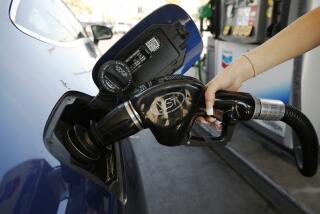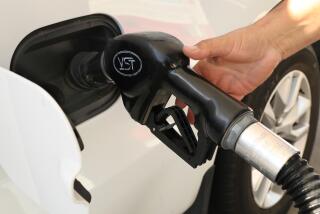Entrepreneurs Fill Service Void at Gas Stations : Air, Water Vending Units Pump Up Profits for Some
- Share via
Jim Paul, manager of an Arco service station in San Juan Capistrano, knows what his customers like and dislike.
“They don’t like paying for air,” says Paul, who believes that it is just not right to charge customers for a service that for years was free.
Many motorists would agree with Paul. But the days when drivers could roll into almost any service station and find air and water hoses next to the gas pumps are rapidly disappearing.
To reduce costs, California service station owners and operators are increasingly installing pay-to-use vending machines for motorists who want to fill up a flat tire or cool down an overheated radiator.
Theft a Problem
The reasons for the change date back to the proliferation of self-service gas stations beginning in the early 1970s, industry representatives say.
In the past, service stations relied on large, costly-to-operate air compressors to not only provide free air to customers but also to power pneumatic wrenches, lifts and other equipment needed for their auto repair services. The conversion to self-serve stations resulted in the elimination of most of those services.
“They now had a big compressor, and the only use for it was for people to put air in their tires,” said Wayne Rogers, owner of a Laguna Hills company that installs and services air and water vending machines. “They were trying to give away free service, but every time they put a hose out or used a compressor it was stolen.”
Rogers saw an opportunity in the making shortly before Jan. 1, 1985, the date a state law went into effect requiring businesses that sell gasoline to provide air and water to their customers. Similar laws are in effect in a number of other states and metropolitan areas.
The law confronted many station operators with a difficult choice, Rogers said. They could either violate the law or they could pay to buy and maintain a small air compressor.
Untapped Market
But the statute also created a new business niche for companies such as Rogers’ Mass Air Systems, which has installed air and water vending machines in more than 600 Southern California gas stations. Mass Air claims to be the largest of a dozen or so small companies in California that install and service such machines.
“I don’t think we’ve touched even 15% of the market” in California, said Rogers, whose goal is to expand his business throughout the West Coast.
Steve Shelton, executive director of the Irvine-based Southern California Service Station Assn., estimates that about half of the 12,000 gas stations in the state are self-service-only outlets. The majority of the air and gas vending machines that have been installed have been at self-service stations.
Shelton said many of the full-service stations operated by large oil companies have shunned pay air and water machines as well as pay restrooms, believing that their customers will resent them. “Most of those operators who own their station are installing this equipment,” he said, “but it is still fairly rare at (oil company) franchise locations.”
Kenneth Boekhaus, manager of new marketing projects for Arco, said the company recently inherited seven air and water vending machines when it purchased some Thrifty Oil Co. stations and has left them in place on a trial basis. “We want to find out how the consumer receives them,” he said.
The company has not decided whether to install the machines at other Arco stations. He said Arco’s management generally frowns on the idea of charging customers for air or water. “Right now our stance is no,” he said. “It could change.”
Mass Air provides free installation and repair for the $2,000 machines it installs at service stations. The station operator receives between 25% and 70% of the gross revenue generated by the equipment, with Mass Air collecting the rest.
The more money a machine generates, the bigger the share the station receives. A heavily used machine can generate $600 a month or more, according to the company, but the average take is closer to $150 a month.
Rogers said his company mainly deals with larger companies that have contracted to place the machines in all of their service stations or gasoline outlets. “It’s more effective to deal with one company with 100 stations than a 100 companies with one station each,” he said. In addition to Thrifty Oil Co., Mass Air Systems has contracts with Jaco Oil Co., Circle K Corp. and Conoco, he said.
Removes a Headache
Mass Air Systems purchases its machines from outside suppliers and modifies them for the California market, making them more resistant to vandalism and high temperatures.
The Laguna Hills firm recently began marketing a new type of machine that allows customers who buy gas to fill their tires free of charge, but requires a 25-cent payment from customers who only want air and water.
The devices are similar to the some service station car washes. A customer who buys gas can use the air and water machine at no cost by punching a numerical “code of the day” supplied by the station attendant. Customers who don’t want to buy gas must pay for air and water service.
Rogers said the newer machines “are more appealing to the big oil companies” that look askance at charging for air and water.
Mike Dodson, director of gasoline for the Western region of Circle K, said vandalism drove his company to make a deal with Mass Air. “Rather than us having an in-house headache, we’ve decided to form an agreement with an outside company,” he said.
Shelton said that vandalism and other maintenance problems would make the idea attractive to a lot of gas station owners. “There has to be some appeal to an operator to have someone come in and take all that off their hands and give them money,” he said.
Some gas station managers say that the service definitely removes a major headache. “People keep coming in and cutting hoses,” said the manager of one Thrifty outlet. “They (Mass Air Systems) come out and take care of it.”
More to Read
Sign up for Essential California
The most important California stories and recommendations in your inbox every morning.
You may occasionally receive promotional content from the Los Angeles Times.










